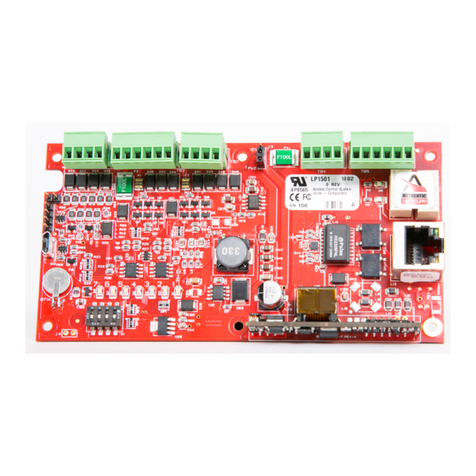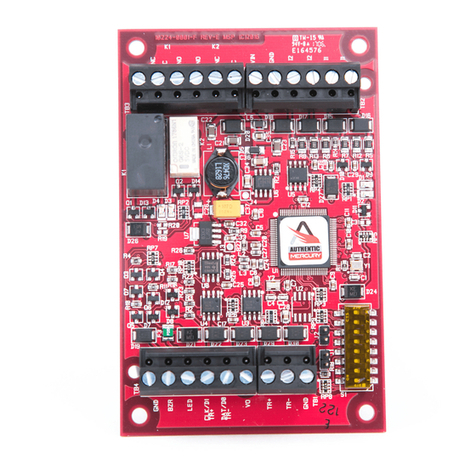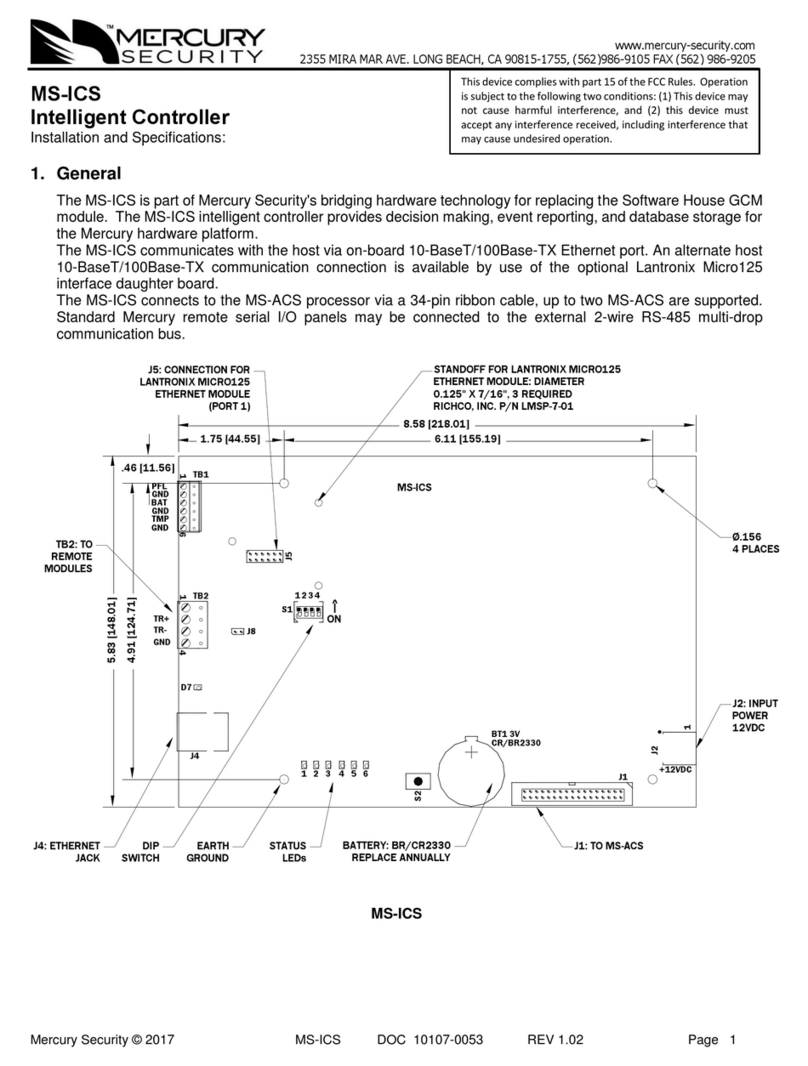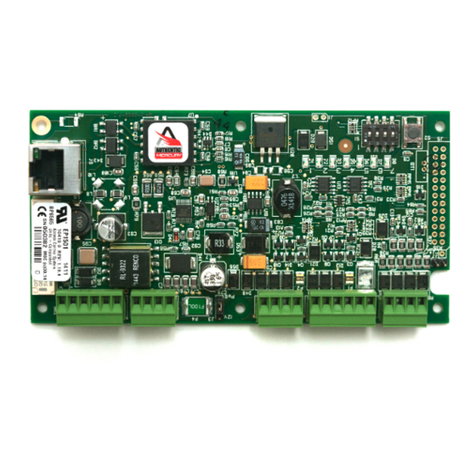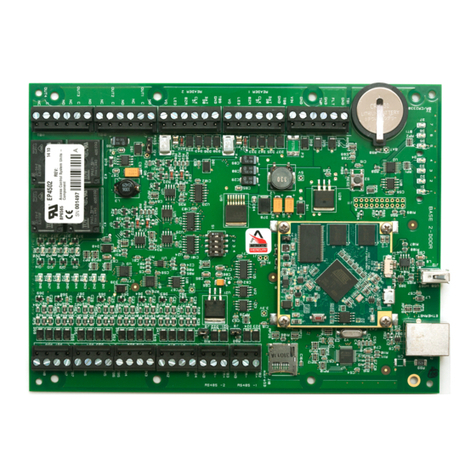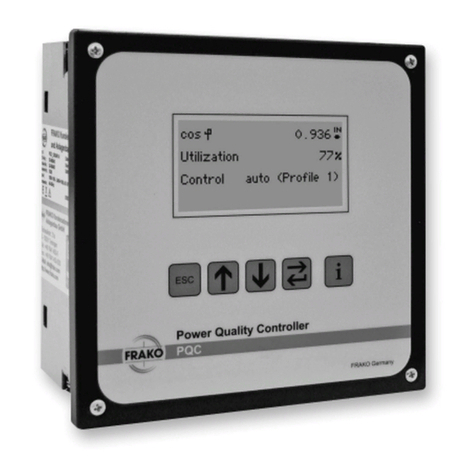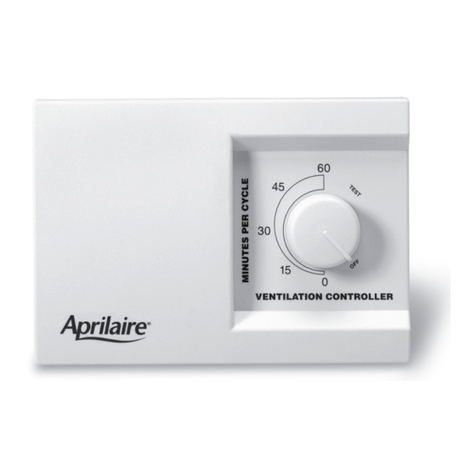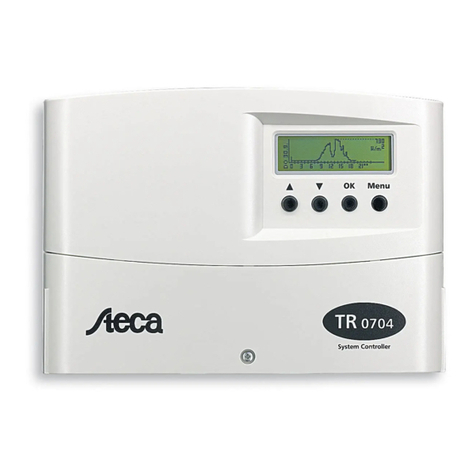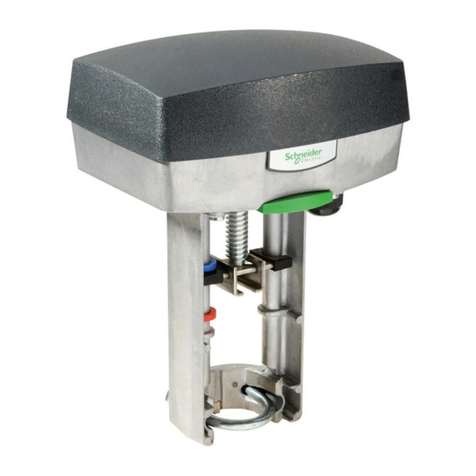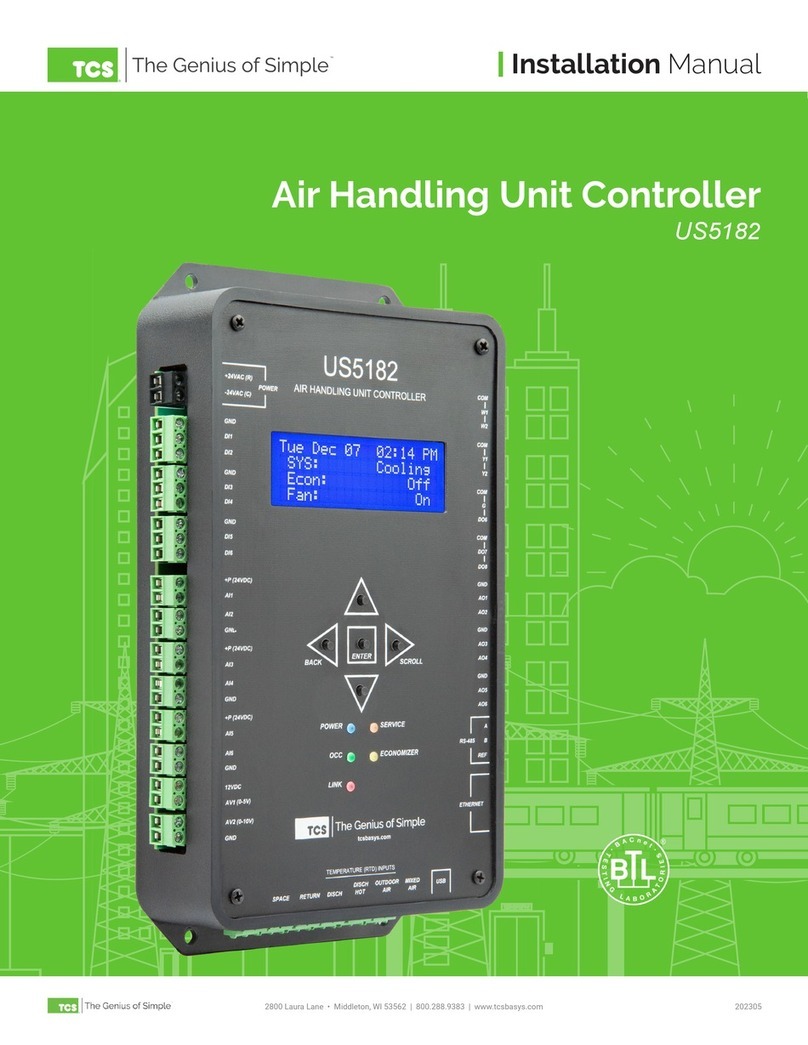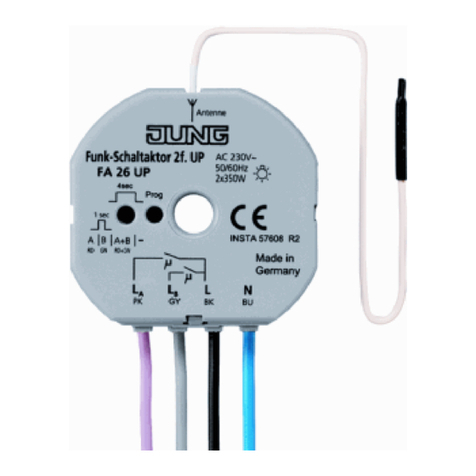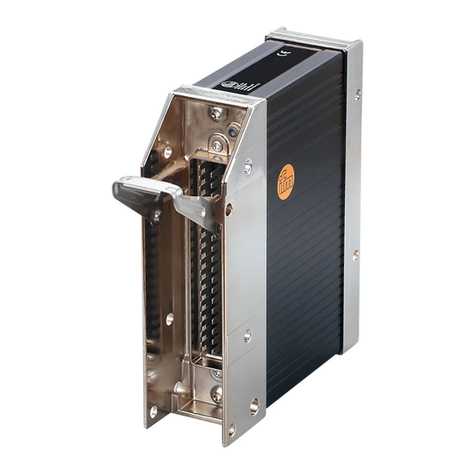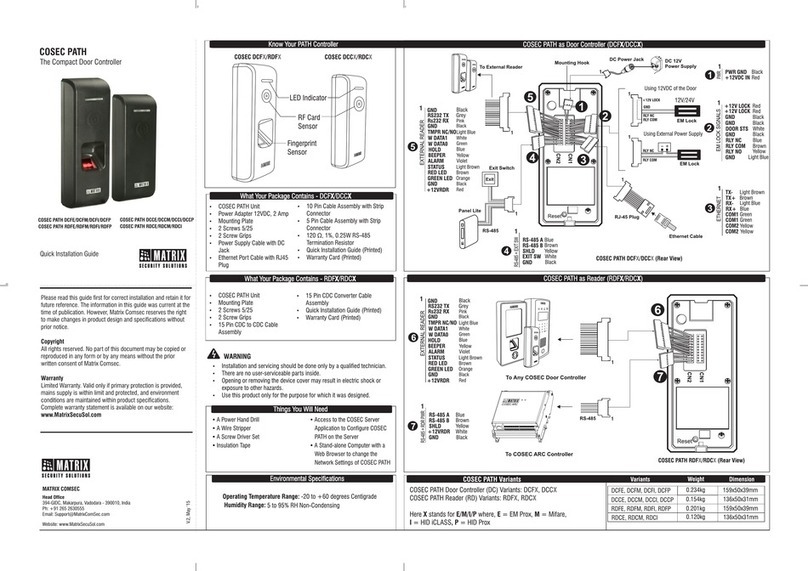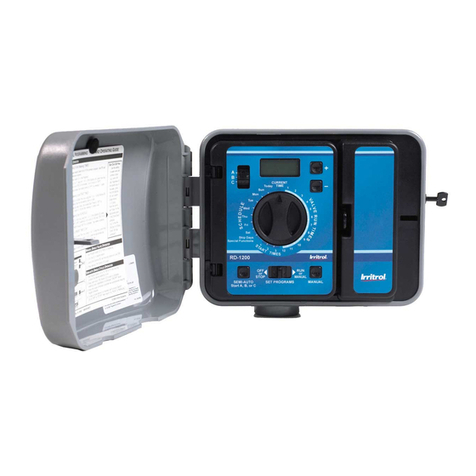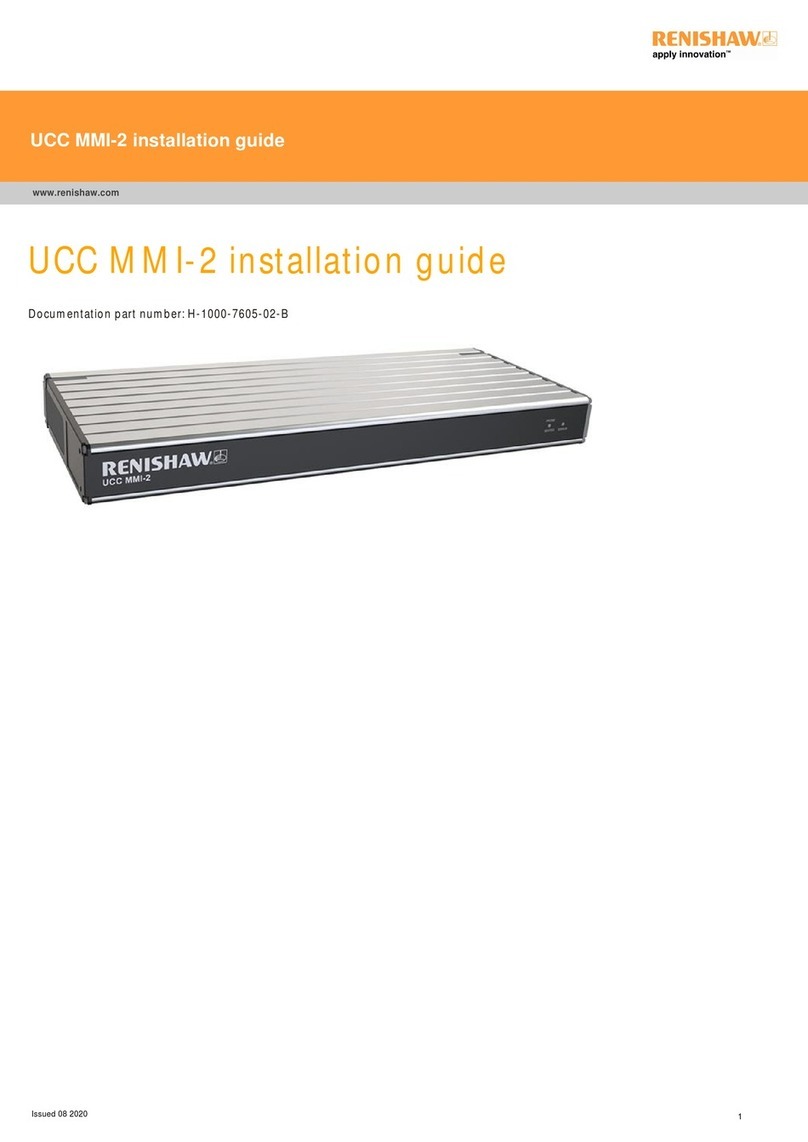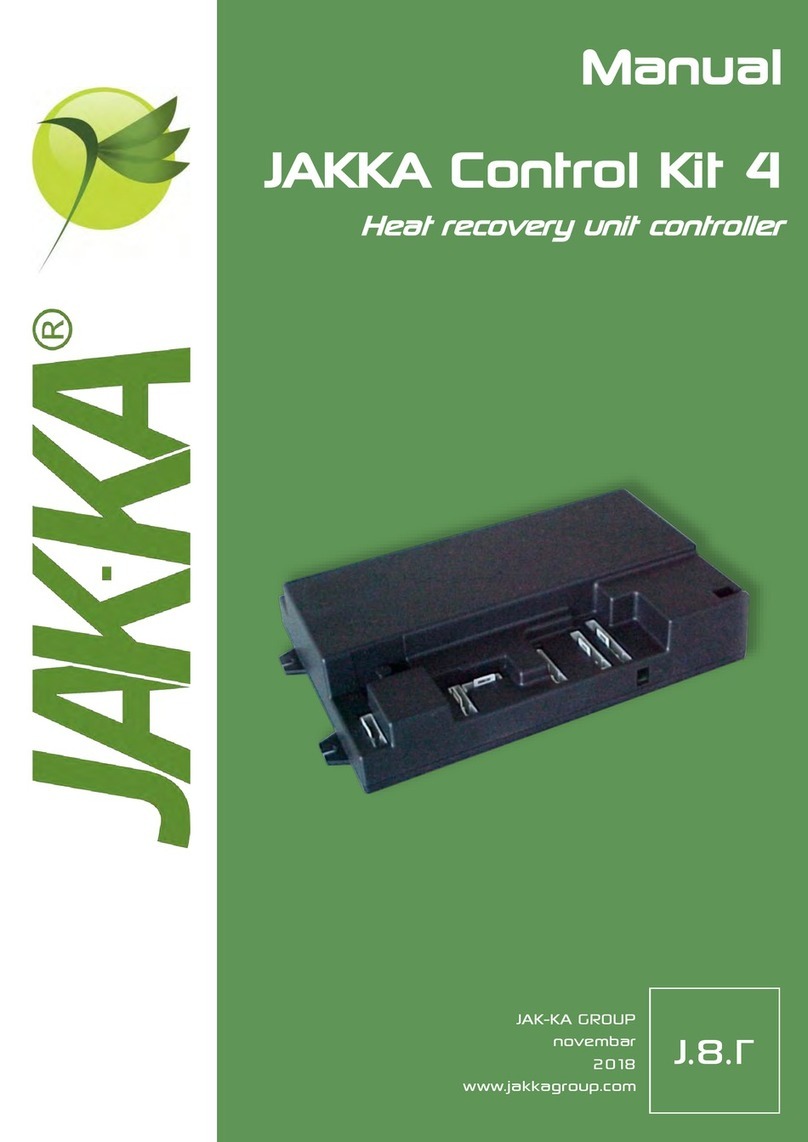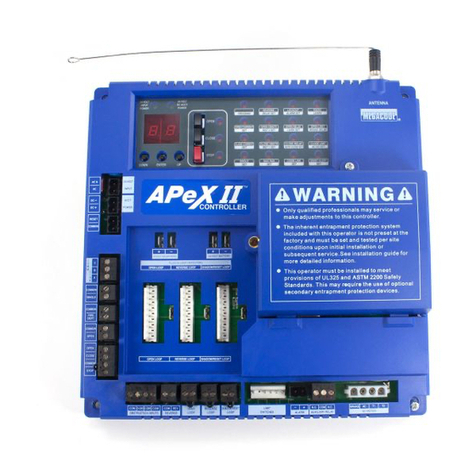Mercury Security EP1502 User manual

Mercury Security © 2015 EP1502 DOC 10107-0031 REV 1.06 Page 1
www.mercury-security.com
2355 MIRA MAR AVE. LONG BEACH, CA 90815-1755, (562)986-9105 FAX (562) 986-9205
EP1502 Intelligent Controller
with Two Reader Interface
Installation and Specifications:
1. General:
The EP1502 intelligent controller provides decision making, event reporting, and database storage for the
Mercury hardware platform. Two reader interfaces provide control for two physical barriers.
The EP1502 communicates with the host via on-board 10-BaseT/100Base-TX Ethernet port. Alternatively,
port 1 (RS-232) can be used for host communication.
Each reader port can accommodate a reader that utilizes TTL (D1/D0, Clock/Data), F/2F, or 2-wire
RS-485 device signaling, and also provides tri-state LED control, and buzzer control (one wire LED mode
only). Four Form-C relay outputs may be used for strike control or alarm signaling. The relay contacts are
rated at 5 A @ 30 Vdc, dry contact configuration. Eight inputs are provided that may be used for monitoring
the door contacts, exit push buttons and alarm contacts. Input circuits may be configured as unsupervised
or supervised. The EP1502 requires 12 to 24 Vdc for power.
2. EP1502 Hardware:
J4
J3
1
2
3
TMP
FLT
R1
R2
+
1
3
2
4
J8
RESET
S2
BT1
3V BR/CR2330
J1
5V
3.3V
2
3
4
1
S1
VBAT
IN1
K
1
K
2
K
3
K
4
K2 K1
K3K4
IN2
IN3
IN4
IN5
IN6
IN7
IN8
8V
J6
J2
J5
J7
PASS 12V
GND
DAT
D0
TB8
READER 1
BZR
VO
GND
FLT
GND
TMP
GND
VIN
TB1
LED
D1
CLK
READER 2
D1
LED
VO
BZR
GND
CLK
D0
DAT
TB9
NO
OUT 1 C
NC
NO
OUT 2 C
NC
NC
OUT 4 C
NC
NO
NO
OUT 3 C
TB10
TB11
RXD
CTS
GND
RTS
TXD
TB2
TB3
TR+
GND
TR-
IN1
IN2
IN3
IN4
IN5
IN6
IN7
IN8
TB4
TB5
TB6
TB7
.25 [6.35] 5.50 [139.70] .25 [6.35]
6.00 [152.40]
.50 [12.70]
2.00 [50.80]
3.00 [76.20]
2.00 [50.80]
.50 [12.70]
8.00 [203.20]
Ø.156 [3.96]
8 PLACES
RESET SWITCH
BATTERY: BR/CR2330
REPLACE ANNUALLY
-
STATUS LED's
DIP SWITCHES
RELAY
STATUS
LED's
INPUT
STATUS
LED's
CHASSIS
GROUND
This device complies with part 15 of the FCC Rules. Operation
is subject to the following two conditions: (1) This device may
not cause harmful interference, and (2) this device must
accept any interference received, including interference that
may cause undesired operation.

Mercury Security © 2015 EP1502 DOC 10107-0031 REV 1.06 Page 2
3. EP1502 Wiring and Setup:
CONNECTION
CONNECTION
TB1-1
Power Fault
GND
TB8-1
Reader 1
GND: Ground
TB1-2
Input
FLT
TB8-2
DAT/D0: Data/Data 0/TR-
TB1-3
Cabinet
GND
TB8-3
CLK/D1: Clock/Data 1/TR+
TB1-4
Tamper Input
TMP
TB8-4
BZR: Reader Buzzer
TB1-5
Power Input
GND
TB8-5
LED: Reader LED
TB1-6
VIN: 12 to 24 Vdc
TB8-6
VO: Reader Power
TB2-1
Host Port 1
GND
TB9-1
Reader 2
GND: Ground
TB2-2
(RS-232)
CTS
TB9-2
DAT/D0: Data/Data 0/TR-
TB2-3
RTS
TB9-3
CLK/D1: Clock/Data 1/TR+
TB2-4
RXD
TB9-4
BZR: Reader Buzzer
TB2-5
TXD
TB9-5
LED: Reader LED
TB3-1
SIO Port
GND
TB9-6
VO: Reader Power
TB3-2
(2-wire RS-485)
TR-
TB10-1
Out 1
NO: Normally Open Contact
TB3-3
TR+
TB10-2
C: Common
TB4-1
Input 2
IN2
TB10-3
NC: Normally Closed Contact
TB4-2
IN2
TB10-4
Out 2
NO: Normally Open Contact
TB4-3
Input 1
IN1
TB10-5
C: Common
TB4-4
IN1
TB10-6
NC: Normally Closed Contact
TB5-1
Input 4
IN4
TB11-1
Out 3
NO: Normally Open Contact
TB5-2
IN4
TB11-2
C: Common
TB5-3
Input 3
IN3
TB11-3
NC: Normally Closed Contact
TB5-4
IN3
TB11-4
Out 4
NO: Normally Open Contact
TB6-1
Input 6
IN6
TB11-5
C: Common
TB6-2
IN6
TB11-6
NC: Normally Closed Contact
TB6-3
Input 5
IN5
TB6-4
IN5
TB7-1
Input 8
IN8
TB7-2
IN8
TB7-3
Input 7
IN7
TB7-4
IN7
Jumpers:
The EP1502 processor hardware interface is configured using jumpers to setup the port interface and end
of line termination.
JUMPERS
SET AT
DESCRIPTION
J1
N/A
Factory Use Only
J2
N/A
10-Base-T/100Base-Tx Ethernet Connection (Port 0)
J3
N/A
Factory Use Only
J4
N/A
Factory Use Only
J5
OFF
Port 2 RS-485 EOL Terminator is Off
ON
Port 2 RS-485 EOL Terminator is On
J6
N/A
Factory Use Only
J7
Reader Power Select. See Note 1
12V
12 Vdc at Reader Ports
PASS
VIN "Pass Through" to Reader Ports
J8-1
N/A
Remote Status LED #1. See Note 2
J8-2
N/A
Remote Status LED #2. See Note 2
J8-3
N/A
Remote Status LED #3. See Note 2
J8-4
N/A
Remote Status LED #4. See Note 2
Note 1: The input power (VIN) must be 20 Vdc minimum if the 12V selection is to be used.
Note 2: Observe POLARITY connection to LED. External current limiting is not required.

Mercury Security © 2015 EP1502 DOC 10107-0031 REV 1.06 Page 3
DIP Switches:
The four switches on S1 DIP switch configure the operating mode of the EP1502 processor. DIP switches
are read on power-up except where noted. Pressing switch S2 causes the EP1502 to reboot.
1
2
3
4
Definitions
OFF
OFF
OFF
OFF
Normal operating mode.
ON
X
X
X
After initialization, enable default User Name (admin) and Password
(password). The switch is read on the fly, no need to re-boot.
See IT Security section for additional information.
OFF
ON
X
OFF
Use factory default communication parameters.
ON
ON
X
OFF
Use OEM default communication parameters. Contact system
manufacture for details. See Bulk Erase below.
X
X
ON
X
Disable TLS secure link. Switch is read only when logging on.
ON
ON
OFF
OFF
Bulk Erase prompt mode at power up. See Bulk Erase below.
All other switch settings for unassigned and are reserved for future use. X = don’t care.
In the factory or OEM default modes, downloaded configuration/database is not saved to flash memory.
Factory Default Communication Parameters:
Network: static IP address: 192.168.0.251
Subnet Mask: 255.255.0.0
Default Gateway: 192.168.0.1
DNS Server: 192.168.0.1
Primary Host port: IP server, no encryption, port 3001, communication address: 0
Alternate Host Port 1: RS-232, 38,400 baud, no encryption, no flow control.
4. Bulk Erase Configuration Memory:
The bulk erase function can be used for the following purposes:
Erase all configuration and cardholder database (sanitize board)
Update OEM default parameters after OEM code has been changed
Recover from database corruption causing EP1502 board to continuously reboot
If clearing the memory does not correct the initialization problem, contact technical support.
Bulk Erase Steps: Do not remove power during steps 1-8.
1. Set S1 DIP switches to: 1 & 2 "ON", 3 & 4 "OFF".
2. Apply power to the EP1502 board.
3. Watch for LEDs 1 & 2 and 3 & 4 to alternately flash at a 0.5 second rate.
4. Within 10 seconds of powering up, change switches 1 or 2 to "OFF". If these switches are not
changed, the EP1502 board will power up using the OEM default communication parameters.
5. LED 2 will flash indicating that the configuration memory is being erased.
6. Full memory erase takes up to 60 seconds.
7. When complete, only LEDs 1 & 4 will flash for 8 seconds.
8. The EP1502 board will reboot 8 seconds after LEDs 1 & 4 stop flashing (no LEDs are on during this
time).
5. Input Power, Cabinet Tamper and UPS Fault Input Wiring:
The EP1502 requires 12 to 24 Vdc power. Locate power source as close
to the unit as possible. Connect power with minimum of 18 AWG wire.
Connect the GND signal to earth ground in ONE LOCATION within the
system! Multiple earth ground connections may cause ground loop
problems and is not advised.
Observe POLARITY on 12 to 24 Vdc input!
There are two dedicated inputs for cabinet tamper and UPS fault
monitoring. Normal (safe) condition is a closed contact. If these inputs are
not used, install a jumper wire.
12 TO 24 Vdc
GND
VIN +
-
CABINET
TAMPER
POWER
FAULT
TB1
TMP
GND
FLT
GND

Mercury Security © 2015 EP1502 DOC 10107-0031 REV 1.06 Page 4
6. Communication Wiring:
The EP1502 controller communicates to the host via the on-board 10-BaseT/100Base-TX Ethernet
interface (port 0) and/or RS-232 interface (port 1). RS-232 interface is for direct one to one connection to
a host computer port or via modem, 25 feet maximum.
The serial I/O device communication port (TB3) is a 2-wire RS-485 interface which can be used to connect
additional I/O panels. The interface allows multi-drop communication on a single bus of up to 4,000 feet
(1,219 m). Use twisted pairs (minimum 24 AWG) with drain wire and shield for communication.
IMPORTANT NOTE! Install the termination jumper ONLY on the panel at each end of the RS-485
bus. Failure to do so will compromise the proper operation of the communication channel!
7. Reader Wiring:
Each reader port supports a reader with TTL (D1/D0, Clock/Data), F/2F, or 2-wire RS-485 signaling. Power
to the readers is selectable: 12 Vdc (VIN must be greater than 20 Vdc), or power is passed-through (PASS)
from the input voltage of the EP1502 (TB1-VIN), 180 mA maximum per reader port. Readers that require
different voltage or have high current requirements must be powered separately. Refer to the reader
manufacture specifications for cabling requirements. In the 2-wire LED mode the buzzer output is used to
drive the second LED. Reader port configuration is set via the host software.
To fully utilize each reader port:
TTL signaling requires a 6-conductor cable (18 AWG)
F/2F signaling requires a 4-conductor cable
RS-485 signaling requires two 2-conductor cables. Use one cable for power (18 AWG) and one
cable for communication (24 AWG, with drain wire and shield)
J7 –Reader Power Select
If the input voltage to the EP1502 is 12 Vdc, jumper J7 MUST be in the PASS position.
RXD
TXD
RTS
CTS
GND
Port 1, RS-232 To Host
TR-
TR+
GND
To serial I/O Devices
TB2 TB3
1
1

Mercury Security © 2015 EP1502 DOC 10107-0031 REV 1.06 Page 5
Typical D1/D0 or Clock/Data Reader
Typical 2-wire RS-485 Device
* Inputs on supervised F/2F readers may be unsupervised or supervised (supervised shown).
Typical Unsupervised F/2F Reader
Typical Supervised F/2F Reader
Jumper D1 to LED on supervised F/2F readers
8. Input Circuit Wiring:
Typically, these inputs are used to monitor door position, request to exit, or alarm contacts. Input circuits
can be configured as unsupervised or supervised. When unsupervised, reporting consists of only the open
or closed states. When configured as supervised, the input circuit will report not only open and closed, but
also open circuit, shorted, grounded*, and foreign voltage*. A supervised input circuit requires two resistors
be added to the circuit to facilitate proper reporting. The standard supervised circuit requires 1k ohm, 1%
resistors and should be located as close to the sensor as possible. Custom end of line (EOL) resistances
may be configured via the host software.
* Grounded and foreign voltage states are not a requirement of UL 294 and therefore not verified by UL
The input circuit wiring configurations shown are supported but may not be typical:
1
TB8 or TB9
VO
LED
BZR
GND
D1/CLK/TR+
D0/DAT/TR-
VO
LED
BZR
D1/CLK/TR+
D0/DAT/TR-
GND
1
TB8 or TB9
VO
LED
BZR
D1/CLK/TR+
D0/DAT/TR-
GND
+12 Vdc
D1
GROUND
DO (GREEN LED)
F/2F Reader
1
TB8 or TB9
1
VO
LED
BZR
D1/CLK/TR+
D0/DAT/TR-
GND
+12 Vdc
D1
GROUND
DO (GREEN LED)
F/2F Reader
NORMALLY CLOSED CONTACT *
DOOR MONITOR SWITCH
REQUEST TO EXIT SWITCH
NORMALLY OPEN CONTACT *
1K,1%
1K,1%
1K,1%
1K,1%
TB8 or TB9
1K,1%
1K,1%
1K,1%
1K,1%
IN4 IN3 IN2 IN1
Standard Supervised Circuit,
Normally Closed Contact
Standard Supervised Circuit,
Normally Open Contact
Unsupervised Circuit,
Normally Open Contact
Unsupervised Circuit,
Normally Closed Contact
Terminal Blocks
TB4 through TB7

Mercury Security © 2015 EP1502 DOC 10107-0031 REV 1.06 Page 6
9. Relay Circuit Wiring:
Four relays with Form-C contacts are provided for controlling door lock mechanisms or alarm signaling.
The relay contacts are rated at 5 A @ 30 Vdc, dry contact configuration. Each relay has a Common pole
(C), a Normally Open pole (NO) and a Normally Closed pole (NC). When you are controlling the delivery
of power to the door strike, the Normally Open and Common poles are used. When momentarily removing
power to unlock the door, as with a mag lock, the Normally Closed and Common poles are used. Check
with local building codes for proper egress door installation.
Door lock mechanisms can generate feedback to the relay circuit that can cause damage and premature
failure of the relay. For this reason, it is recommended that a diode be used to protect the relay. Wire
should be of sufficient gauge to avoid voltage loss.
10.Memory and Real Time Clock Backup Battery:
The static RAM and the real time clock are backed up by a lithium battery when input power is removed.
This battery should be replaced annually. If data in the static RAM is determined to be corrupt after power
up, all data, including flash memory, is considered invalid and is erased All configuration data must be re-
downloaded. Remove the insulator from the battery holder after installation. Battery type: BR2325,
BR2330, or CR2330.
11.IT Security
When installing the EP1502, it is important to ensure that it done in a secure manner.
Upon installation, the user accounts to the web configuration page should be created with secure
passwords, and that all DIP switches are in the off position for the normal operating mode. The EP1502
is shipped from the factory with a default login account, which is enabled when DIP 1 is moved from OFF
to ON. The default login user name and password will be available for five minutes once enabled.
Therefore, it is important that at least one user account is defined, and the DIP switches are set to OFF
before the EP1502 is commissioned. It is also highly recommended not to configure the EP1502 with an
IP address that is accessible from the public Internet.
To further enhance network security, options are available to disable SNMP, Zeroconf discovery, as well
as the web configuration module itself. Additionally, data encryption can also be enabled over the host
communication port.
12.Status LEDs:
Power-up: All LED's OFF.
Initialization: LED's 1, 2, 3, TMP, FLT, R1, R2, IN1, IN2, IN3, IN4, IN5, IN6, IN7 and IN8 are sequenced
during initialization. LED's 1, 3, and TMP are turned ON for approximately 4 seconds after the hardware
initialization has completed, then the application code is initialized. The amount of time the application
takes to initialize depends on the size of the database, about 3 seconds without a card database. Each
10,000 cards will add about 3 seconds to the application initialization. When LED's 1, 2, 3 and TMP flash
at the same time, data is being read from or written to flash memory, do not cycle power when in this
state.
Diode Selection:
Diode current rating: 1x strike current
Diode breakdown voltage: 4x strike voltage
For 12 Vdc or 24 Vdc strike, diode 1N4002
(100V/1A) typical.

Mercury Security © 2015 EP1502 DOC 10107-0031 REV 1.06 Page 7
Running: After initialization is complete, the LEDs have the following meanings: At power up, LEDs 2
through 6 are turned ON then OFF in sequence.
LED
DESCRIPTION
1
Off-Line / On-Line and Battery Status
Off-Line = 20% ON, On-Line = 80% ON
Double Flash if Battery is Low
2
Host Communication Activity (Ethernet or Serial Port 1)
3
Internal SIO Communication Activity
TMP
External SIO Communication Activity
FLT
Unassigned
R1
Reader 1:
Clock/Data or D1/D0 Mode: Flashes when Data is Received, Either Input
F/2F Mode: Flashes when Data/Acknowledgment is Received
RS-485 Mode: Flashes when Transmitting Data
R2
Reader 2:
Clock/Data or D1/D0 Mode: Flashes when Data is Received, Either Input
F/2F Mode: Flashes when Data/Acknowledgment is Received
RS-485 Mode = Flashes when Transmitting Data
D16
Flashes with Host Communication (Ethernet Port 0)
YEL
Ethernet Speed: OFF = 10Mb/S, ON = 100Mb/S
GRN
OFF = No Link, ON = Good Link, Flashing = Ethernet Activity
IN1
Input IN1 Status: OFF = Inactive, ON = Active, Flash = Trouble. See Note 1.
IN2
Input IN2 Status: OFF = Inactive, ON = Active, Flash = Trouble. See Note 1.
IN3
Input IN3 Status: OFF = Inactive, ON = Active, Flash = Trouble. See Note 1.
IN4
Input IN4 Status: OFF = Inactive, ON = Active, Flash = Trouble. See Note 1.
IN5
Input IN5 Status: OFF = Inactive, ON = Active, Flash = Trouble. See Note 1.
IN6
Input IN6 Status: OFF = Inactive, ON = Active, Flash = Trouble. See Note 1.
IN7
Input IN7 Status: OFF = Inactive, ON = Active, Flash = Trouble. See Note 1.
IN8
Input IN8 Status: OFF = Inactive, ON = Active, Flash = Trouble. See Note 1.
K1
Relay K1: ON = Energized
K2
Relay K2: ON = Energized
K3
Relay K3: ON = Energized
K4
Relay K4: ON = Energized
Note 1: If this input is defined, every three seconds the LED is pulsed to its opposite state for 0.1
seconds, otherwise, the LED is off.
13.Specifications:
The interface is for use in low voltage, Class 2 Circuits only.
The installation of this device must comply with all local fire and electrical codes.
Primary Power: 12 to 24 Vdc ± 10 %, 500 mA maximum (reader current not included)
Memory and Clock
Backup Battery: 3 Volt Lithium, type BR2325, BR2330 or CR2330
Host Communication: Ethernet: 10-BaseT/100Base-TX, and RS-232: 9,600 to 115,200 bps
Serial I/O Device 2-wire RS-485: 2,400 to 115,200 bps
Inputs: Eight unsupervised/supervised, standard EOL: 1k/1k ohm, 1%, ¼ watt
Two unsupervised dedicated for cabinet tamper and UPS fault monitoring
Outputs: Four relays: Form-C, 5 A @ 30 Vdc, resistive

Mercury Security © 2015 EP1502 DOC 10107-0031 REV 1.06 Page 8
Reader Interface:
Power: 12 Vdc ± 10 % regulated, 180 mA maximum each reader
(jumper selectable) (input voltage (VIN) must be greater than 20 Vdc)
or
12 to 24 Vdc ± 10 % (input voltage passed through), 180 mA maximum each
reader
Data Inputs: TTL compatible, F/2F or 2-wire RS-485
LED Output: TTL levels, high>3 V, low<0.5 V, 5 mA source/sink maximum
Buzzer Output: Open collector, 12 Vdc open circuit maximum, 40 mA sink maximum
Cable requirements:
Power: 1 twisted pair, 18 AWG
Ethernet: CAT-5, minimum
RS-485:
(I/O Device Port): 1 twisted pair with drain wire and shield, 24 AWG, 4,000 ft. (1,219 m) max.
(Reader Port): 1 twisted pair with drain wire and shield, 24 AWG, 2,000 ft. (610 m) max.
RS-232: 3 or 5-conductor, 24 AWG, 25 ft. (7.6 m) maximum
Alarm Input: 1 twisted pair, 30 ohms maximum
Mechanical:
Dimension: 8 in. (203.2 mm) W x 6 in. (152.4 mm) L x 1 in. (25 mm) H
Weight: 9 oz. (255 g) nominal, board only
Environmental:
Temperature: -55 to +85 °C, storage
0 to +70 °C, operating
Humidity: 5 to 95 % RHNC
Warranty
Mercury Security warrants the product is free from defects in material and workmanship under normal use
and service with proper maintenance for one year from the date of factory shipment. Mercury Security
assumes no responsibility for products damaged by improper handling or installation. This warranty is
limited to the repair or replacement of the defective unit.
There are no expressed warranties other than set forth herein. Mercury Security does not make, nor
intends, nor does it authorize any agent or representative to make any other warranties, or implied
warranties, and expressly excludes and disclaims all implied warranties of merchantability or fitness for a
particular purpose.
Returns must be accompanied by a Return Material Authorization (RMA) number obtained from customer
service, and prepaid postage and insurance.
Liability
The Interface should only be used to control exits from areas where an alternative method for exit is
available. This product is not intended for, nor is rated for operation in life-critical control applications.
Mercury Security is not liable under any circumstances for loss or damage caused by or partially caused
by the misapplication or malfunction of the product. Mercury Security’s liability does not extend beyond the
purchase price of the product.
Table of contents
Other Mercury Security Controllers manuals
